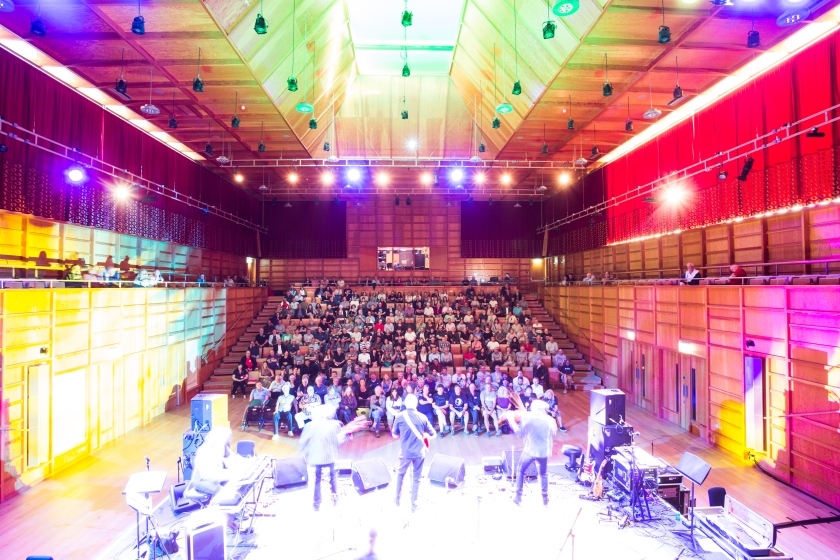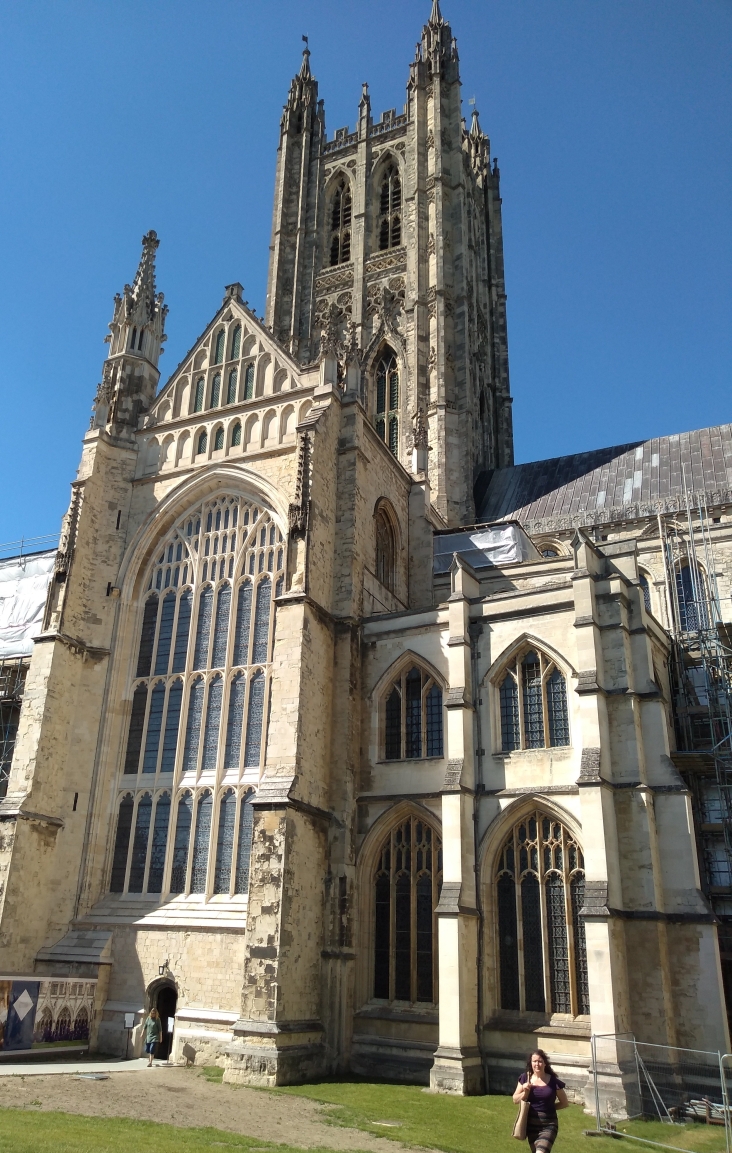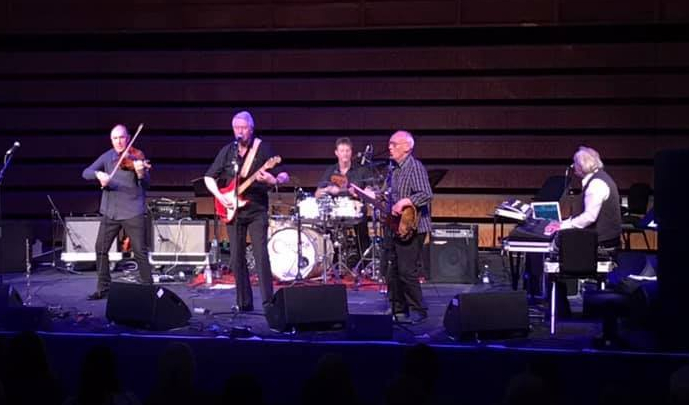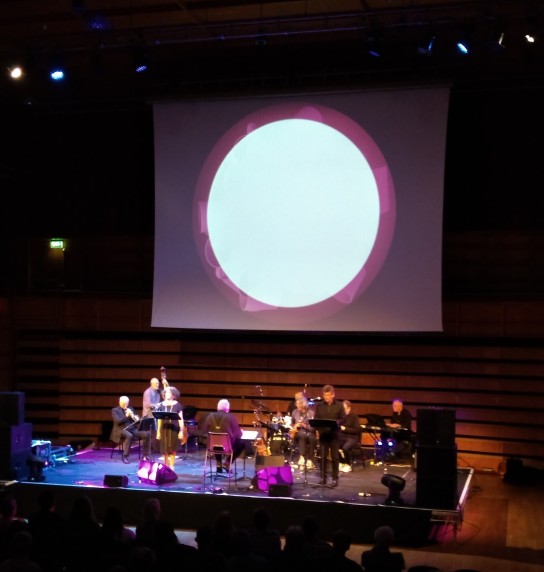
Caravan at the Gulbenkian: photo Jason Pay
If you’ve been invited to speak in a city whose music you’ve been writing about for 30 years, it’s probably best not to start with an opening gambit of “this is only the second time I’ve been to Canterbury”, but that was how I started my talk at the Canterbury Sound event held at Christchurch University in 2017.
I could sense the room visibly bristle even as I said it. The nature of that second trip to Canterbury (arriving late on Friday night with the whole of the next day spent indoors) meant that I left on the Sunday morning still not much the wiser as to the charms of the city. I vowed to rectify this at some point in the future, for, after all, it’s a bit contradictory making a couple of ‘pilgrimages’ to Deia in Mallorca on the basis of a Canterbury connection if you’ve barely experienced Canterbury itself.
The perfect excuse came with the Gulbenkian Arts Centre’s 50th birthday celebrations and an ambitious program of events which peaked with Saturday evening’s Soft Machine/Caravan double header (and much more..) but also included: a ‘New Canterbury Sound’ event on the Friday evening; a multimedia event the previous Monday based around ‘You Are Here’, the innovative history of the city from Matthew Watkins, who has done more than most to bridge the gap between old and new Canterbury sounds and is a champion of both; and an album airing of Caravan’s ‘For Girls Who Grow Plump In The Night’ on a lazy Sunday afternoon, featuring the thoughts of participants Pye Hastings, Geoffrey Richardson and producer David Hitchcock. Sadly our trip would only be able to incorporate the middle two events, but with no less than 10 musical acts to peruse within them, this would be rich pickings indeed.

On the longest day of the year (and possibly the hottest) a drive down from West Yorkshire and an unintended hour-long walk from our campsite through town and up the hill towards the Gulbenkian (I’d foolishly not realised that this arts complex is part of an extensive out of town university campus) meant that we arrived a little hot and bothered but in time to catch the last couple of tracks from the mellow groovings of Jouis. We were greeted by a beaming Joel Magill, from the Dawn Chorus Recording Company. Curator of tonight’s impressive 6-band billing, he is known best to us as the bass player with Syd Arthur, and as a new dad presumably currently surviving life purely through bonhomie and the fumes of adrenaline. Either way he seemed as unphased as it is possible to be as the MC of an event as ambitious as this. The evening, which had been running since about 7 o’clock, alternated bands between the Gulbenkian café, an intimate ground floor setting, with its music filtering out through the open doors on to campus; and the more stark artsy surroundings of the Theatre with its black stage, tiered seating and dimmed lights.

Nelson Parade
The first band we saw in its entirety was Nelson Parade. I knew there was a Syd Arthur connection here, but hadn’t quite unpicked the link. Syd Arthur’s music more recently has trimmed itself down from its folky roots to something more poppy and electronic, simplifying the rhythms and favouring a more direct approach. This is mirrored to some extent too by drummer Josh Magill’s new project Joshua, and even some website material I’ve heard from violinist/mandolin player Raven Bush. Nelson Parade appear to be ploughing a broadly similar furrow (they label themselves psych pop), but there were a few surprises en route. Firstly, they are fronted by a fourth Magill brother, Callum, mop-haired and bespectacled. I am only familiar with his superb work with The Boot Lagoon, who featured his cacophonous distorted keyboard work providing the textures to seriously groovy music – one Facelift contributor reckoned they was closer to the Canterbury scene sound of Caravan than anything that Syd Arthur purveyed. Nelson Parade on the other hand are a four piece featuring Callum on vocals behind a keyboard (and occasionally guitar), with brothers Josh and Joel on drums and bass respectively, with further guitar stage right. This was a performance of unexpected showmanship.

Josh and Callum Magill, Nelson Parade
Like Syd Arthur’s front man Liam Magill, Callum has a voice which dips in and out of falsetto, and a certain nervous energy underpinning his body language, but this was much more sharply characterised material than Syd Arthur’s often gentle tunes. I was expecting to sit watching this performance in a certain amount of quiet approval at cleverly crafted pop without ever fully being convinced, but it was almost as if a band with credentials such as this couldn’t help themselves in reaching out into more exploratory territories, firstly through a bossa novaish piece ‘Go Home Nelson’ recalling Caravan’s themes and sounds, then through a final piece (possibly ‘Kevin crashed and then woke up’?)where 3 members of the band ended up front of stage, widdling effects boxes in a mesmeric, psychedelic finale. Apologies for the lack of further details here – this was a band completely new to me and I intend to check out further material at https://nelsonparade.bandcamp.com/releases

Lapis Lazuli
And so back to the café and the hotly anticipated Lapis Lazuli. I was musing on the long drive down that on average each journey I’ve made to see this remarkable band has involved a 500 mile round trip. It must say something about the band that this seems quite a relatively reasonable undertaking to make given the effort which goes into creating their own astonishingly complex compositions. And for all the initial euphoria of seeing them in Canterbury in 2017 and the Kozfest performance in 2018 where they provided a memorable antidote to the dronish fayre which dominates there, this gig was undoubtedly even more extraordinary.


Adam Brodigan & Neil Sullivan, Lapis Lazuli
Helped by razor sharp drum sounds and a conducive setting where the crowd (complete with several small children running free) and band seemed to merge into a single entranced mob, the band performed three tracks from their most recent album ‘Brain’, all breathtaking in their audacious composition and execution. As one punter remarked, this is a heavier Lapis Lazuli, eschewing any remnants of acousticity into a noisy guitar-driven pulverisation of the senses. New guitarist Martin took the place of Dan Lander and musically made it a seamless transition, but centre stage was the lead work of Neil Sullivan, all flailing hair and strides which matched the purple curtain backdrop; the dextrous precision of drummer Adam Brodigan; and the irrepressible presence of Luke Mennis, who not only lives and breathes every note he plays, but is similarly consumed by that of those around him.

Luke Mennis, Lapis Lazuli
The set started with the fiendishly complex and euphorically delivered ‘Low Key’ and of course was concluded by the new Lapis anthem ‘Hired Soul’, but for me the highlight, unexpectedly, was the stop-start confusion of ‘The Slug’, which extended out into an impossibly catchy groove – for the first time I made the link between this and hypnosis of ‘We Did It Again’ as the crowd were expertly wound up into a frenzy. I could quite happily have jumped back into my car and driven home at this point, so peerless was this performance, although other drivers might not have thanked me for that…

Evil Usses on stage
How to wind down? Certainly not with the evening’s headliners the Evil Usses who finished things off in the theatre. Given the stilted Italian announcements coming from the behind the saxophone/keyboard player’s microphone and the exotic hairstyle of the guitarist, who possesses enough extravagant plumes to block up several plumbing systems, one got the impression this band, clearly not from Canterbury, had been flown in for the occasion. In fact they’d made a hop across the country from Bristol – we’d spied their green van, containing some likely looking types on our trip down the M2.

Evil Usses
The Evil Usses were unfathomably brilliant, fuelled by hypnotic, rhythmic bass lines, driving drumming and some sonically stark overlays, be it sax soloing, keyboard effects or abrasive guitar lines. Like Nelson Parade, Evil Usses slowly wound up the audience with ever more weird grooves up to the point where there was a modest stage invasion of around 20 or so hairies of various genders and ages (including most of Lapis Lazuli) gyrating together across the front of the rather large stage front which had previously been stalked by the wonderfully coiffured guitarist.
I left feeling that our first night at the Gulbenkian was one of the best evenings of music I could ever recall. But this was merely the aperitif.
Saturday was a chance to finally look around Canterbury. It’s a strange mix of components: the cathedral an imposing presence from practically every vantage point outside of the city walls, but often obscured from within. The character of some of the older streets and buildings is somewhat subsumed between the inevitable chain stores which abound – even the pedestrian area which has thankfully materialised in the centre of the city could have been transplanted from any other town, with a shortage of places to sit out and absorb the atmosphere on a sunny summer’s day. And yes, we fitted in a trip to the Cathedral, with its colossal dimensions, where a full orchestra practiced for a future performance in the nave, the singers’ voices echoing muddily around the vast indoor cavities.

gratuitous Cathedral shot
Strangely enough I’d been expecting Canterbury in general to be much more oppressively busy – it was still possible to catch a few reflective moments in the Cathedral’s herb garden, or some of the smaller chapels, until we were beset by a group of fellow visitors led by a member of the local clergy plummily reciting an anecdote about the Queen. Refuelling with a fine veggie meal, we started to slowly edge in the direction of the Gulbenkian, conscious that it would be a good idea to arrive somewhat more promptly tonight.
On the way the local Oxfam had a few CDs for sale, and within its limited non-classical catalogue I spotted no less than 6 albums worth buying for a couple of quid each: Steve Hillage’s ‘L’, two Caveman Shoestore albums from their period before Hugh Hopper joined them, The Polite Force album ‘Canterbury Knights’ (something of a gem) and two albums by the Orb from their later era. If I’d probably already got a couple of these artefacts at home, it seemed rude not to snap them up, the shop was about to close so I wouldn’t be denying anyone the chance. Except that another punter going through the same thought process arrived a minutes later and whilst we exchanged a few words identifying our affiliation with the ‘scene’, I felt a few pangs of guilt.

And so to the evening’s proceedings. We’d been told by a couple of people en route that the ‘Canterbury Sound’ event would start at 6 prompt with Jack Hues, and as I wanted to see the whole evening, we grabbed a bus and arrived at the Gulbenkian with just enough time to snatch a quick word with Aymeric Leroy and spot various performers in the milling crowd, John Marshall and Pye Hastings amongst them, navigating their way around the complex. The concert hall was a much grander setting than even the previous night’s theatre, and our seats were somewhere up in the gods surveying the night’s performances – great for a visual overview, less so for a closeup experience. In the foyer there was merchandise from both Soft Machine and Caravan, the latter sporting some natty new T-shirts and flyers advertising a forthcoming 30 CD box set!

Jack Hues was a fellow speaker at that Canterbury sound event in 2017, a musician with latterday connections to the city through his role as a music tutor at Christchurch University, although his own musical pedigree stretches back to the Eighties with Wang Chung. At that 2017 event his own guitar work was backed with his jazz band The Quartet, plus various evocative spoken word passages. However, since then, a vinyl release of a cover of Beck’s ‘Nobody’s Fault But My Own’, backed not only by the Quartet but also by members of Syd Arthur had appeared, resurrecting a connection dating back to 2010 when the larger ensemble had performed Soft Machine’s classic composition ‘Facelift’. Tonight’s line-up was shorn of Liam Magill but contained brothers Josh and Joel, as well as saxophonist Chris Williams, plus the three other members of the Quartet. The band perform impressionistic music, flitting in and out of soundscapes, intertwining recurring themes and occasionally moving off into free jazz territory. The opener was indeed ‘Nobody’s Fault’ but was followed by a new self-composed piece ‘Non Locality in a Sea of Electrons’ which in many ways was the most impressive part of the set, with guitar, keyboard and sax following a singular theme before some muscular drum’n’squawk rhythms a la Bill Bruford’s Earthworks, and a sustained guitar conclusion.

Jack Hues' The Quartet featuring Syd Arthur: Photo Jason Pay
The third track was a homage to Talk Talk’s Mark Hollis with a cover of ‘Myrrhman’, with a church-organ like ethereality, but as hoped, the climax was the band’s cover of ‘Facelift’. Joel Magill had alluded to the performance of this the previous day when I’d asked him directly whether or not it would be performed – he would only go as far as smilingly admitting ‘It would be rude not to…’ The rendition of any Canterbury classic, albeit one which lends itself to a certain amount of free interpretation, implies a certain level of self-confidence, but there is no doubt that the Quartet carried it off, largely as a combination of an initial section which bore practically no relation to Mike Ratledge’s original brutalities (I was reminded of The Orb’s reinterpretation of a Gong song where they took a couple of notes only and went off on a seemingly tangential journey); and a rather fine middle section where the main riff, with two sets of drums, and both electric and and acoustic basses chuntered on in fine style. I’m sure Hugh would have approved of both this and the Patrice Meyer-like guitar solo, Jack Hues’ finest moment of the night, which followed.
At some point during ‘Facelift’ I spotted John Etheridge wander into the auditorium for a peek, presumably drawn in by a familiar riff and intrigued by its interpretation – this is also a track which the current Soft Machine have in their repertoire. Or possibly he had just been made aware of the change in the running order, which meant that Caravan, rather than the Softs, would perform next.

Caravan (photo: William Hayter)
This was the same Caravan line-up I’d seen in Bury in 2017, performing a slightly pared down set to meet the demands of a packed evening’s schedule, but with a set list reflecting, as in Bury, both the old and the new. Missing was that gig’s highlight ‘Love In Your Eye’ but added was ‘Nightmare’, a piece I’ve never given much time to it in its original form, but here beautifully conceived and executed with some stunning viola work. If only it had been followed by the ‘Last Unicorn’… The classics ‘Golf Girl’ and ‘I Wish I Were Stoned’ were both aired, the former made memorable by percussion from spoons and washboard, and the extended opus tonight was ‘Nine Feet Underground’, more of which later. A healthy smattering of more recent material appeared in the middle of the set, sounding a little stronger on second hearing for me, with again, ‘Dead Man Walking’ by some distance the classiest tune in this regard.

Geoffrey Richardson, Pye Hastings, Jim Leverton: Photo Jason Pay
One of the advantages of our crow’s nest seats was that we had a full panorama of the band, and were able to see what a fine drummer Mark Walker is, with clear sensitivity to all the dynamics of the show. Perhaps unfairly he will probably always be seen as having unfathomably large boots to fill in the form of the much-loved Richard Coughlan, something that hopefully recedes over time as it has with the roles of Jim Leverton and Jan Schelhaas, given their longevity in the band. Again, our vantage point revealed quite how effortless the latter’s keyboard work is – yes, he can roll out those Dave Sinclair solos, but as it’s fairly pointless in trying to compete with, in my opinion, the genre’s finest soloist, he’s done something much cleverer, i.e. infused the music with something much more his own. Rather than those melodic, soar-across-the-hills solos of Dave Sinclair, Schelhaas is a boogier, a honky-tonk groover and I loved his work tonight.

Caravan from left - Jan Schelhaas, Geoffrey Richardson, Pye Hastings, Jim Leverton, Mark Walker: Photo Jason Pay
One of the bonuses of having such versatility around is that when the ship goes off course, there are plenty of skilled hands on deck to bring things back in line. Such was the case with Pye Hastings’ ongoing struggle with his guitar sound, particularly during ‘Nine Feet Underground’. Quite what caused this remains a mystery, but his own anguish at an irresolvable problem was made light of as the gaps in the sound were filled by keyboards and who knows what array of instrumentation by Geoffrey Richardson – it was expertly enough done for us to perhaps never know whether the inspired picked out solo on the viola was scheduled or not. Any doubts that Caravan were the main draw for much of the crowd, despite their set starting at 7.30(!) was dispelled by the heartfelt standing ovation they received at the end of the set.

Soft Machine (photo William Hayter)
Presumably Soft Machine’s elevation to second last slot was due to their involvement in the final piece too. Either way their own performance too built on recent setlists, with their airing of much of ‘Hidden Details’ very much on merit – this is such a strong record of largely original new music that it should be no other way.

Theo Travis & John Etheridge: Photo Jason Pay
Kicking off their set with the album’s title track, it struck me what a strong opening statement John Etheridge was making: in the world of keyboard sophistication often associated with the Canterbury scene, here was a virtuoso ripping through abrasive guitar styles, deliberately leaving notes hanging, Hendrix style, in the air. Things calmed down a bit with another beautiful rendition of ‘The Man Who Waved At Trains’ with its echoed loops courtesy of Theo Travis and then the double header of subtle Etheridge tunes ‘Heart Off Guard’ and ‘Broken Hill’ provided poignancy. ‘Life On Bridges’, whilst lacking perhaps some of the album’s pinpoint accuracy in its triplicate main theme nevertheless made sense of its free jazz section in a way I’d not encountered before. If ‘Golf Girl’ had been Caravan’s anthem tonight, then the Soft Machine’s was the relatively faithful performance of ‘Out-bloody-rageous’, originally recorded around the same time, and reminding us just quite how far the two bands had diverged even by the start of the Seventies when the latter band still had some of its founding members.

Roy Babbington: Photo Jason Pay
Again our high viewing position made for an excellent perspective of each musician’s playing, and our view of John Marshall’s navigation around his kit was a privilege, and not just on his startling solo in the medley which combines ‘The Relegation of Pluto’, ‘Tarabos’ and ‘Hazard Profile’. The latter track, driven along via monstrously low-slung bass sounds from Roy Babbington saw the guitar high notes missing from Etheridge’s solo on ‘Hidden Details’ appear triumphantly to conclude the set.
And so to the finale, ‘Zoom’. For me this might best be described as a ‘curio’ rather than the crescendo of the evening it was billed as. Probably more in keeping with its performance art-based surrounds than the musical genre of the two bands which preceded it, this was a 30 minute piece mixing projected visuals, spoken word (penned by Poet Laureate Simon Armitage) and music based around pre-recorded compositions, partly electronic, from John Harle. The link to the evening’s other events was the appearance in a 6 strong band of the entire Soft Machine.

Zoom (from left: Mike Lovatt, Roy Babbington, Nicole Tibbels, John Harle, John Marshall, John Etheridge, Graham Bickley, Theo Travis, Steve Lodder)
Harle’s program notes made much mention of his own influences from prog rock through to the avant garde but personally I struggled to find obvious references to either in terms of sophistication – the music was neither striking enough, nor weird enough to leave an indelible memory. The role of the Soft Machinists too appeared to be minimal – one brief, effortlessly flurried solo from John Etheridge and a couple of unfurlings of Roy Babbington’s double bass being the main events of note with undoubtedly more musical impact coming from the keyboards of Steve Lodder. The spoken words I felt divided the audience: some were heartily guffawing at the witticisms within them whilst others who looked somewhat bewildered by proceedings. It would take a second viewing of this performance or access to the written material contained within to unwrap it all – or maybe just a different audience. In some ways this was rather a strange end to the evening, with many of the crowd having already left, and the exhilaration of the response to the earlier acts having somewhat dissipated. Kudos however to Harle for not only putting into practice a mixed arts performance not seen in connection to the Soft Machine for …. well…. 50 years, and for curating a bill which paired Soft Machine and Caravan together for the first time in well over 40. All adding to the sense which had built through the weekend that Canterbury music in all its forms is very much alive and kicking.

In conversation with Pye on Sunday (both in The Gulbenkian and later over dinner at Cafe du Soleil) he explained that the battery within his Strat packed up and could not be readily replaced. You may have noticed during the set that Geoffrey fetched a sunburst Strat which proved ineffective. As a result of all this there was much impromptu fill from both Geoffrey and Jan and Pye himself confessed that he “mimed” all his guitar work on “Nine Feet”!!
LikeLike
Cheers Phil, that clears that one up! It didn’t dominate things for me as much as some other people seem to have made out – a shame but c’est la vie. Good music will out!
LikeLike